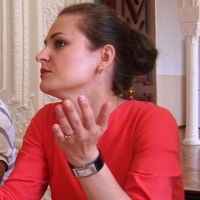
Olena Muradyan
Related Authors
Lyudmyla Zahvoyska
Ukrainian National Forestry University
Олександр Малишев / Oleksandr Malyshev
National Academy of Sciences of Ukraine
Оксана Кукуруз / Oksana Kukuruz
National Academy of Sciences of Ukraine
Anastasiia Ivanova / Анастасія Іванова
National Academy of Sciences of Ukraine
Volodymyr Burak
Ivan Franko National University of Lviv
InterestsView All (7)










Uploads
Papers by Olena Muradyan
The fundamental scientific problem connected with the lack of sociological knowledge about the essence and characteristics of the new social inequalities is actualized in the article. Taking into account the extremely complicated social situation in Ukraine after the turning points of the year 2014, the author points out the growth of social tension caused by the growing contradictions and social stratification, and concludes that it is necessary to find ways to reduce tensions and counteract social stratification. For this, the author proposes to carry out a large-scale analysis of new social inequalities as the most relevant and hypothetically most significant for modern processes. Noting the extremely blurred and non-specific nature of the concept of «new social inequalities», the author considers it necessary to develop the bases of analysis, beginning with the conceptual-terminological level. For this, the author undertakes a heuristic analysis of the concept of «new social inequalities» and the epistemological perspectives of investigating the political representation of new social inequalities. The author comes to the conclusion that it is possible to overcome the terminological and analytical difficulties of researching new social inequalities by concentrating the analysis on their political representation as it’s not only reflecting, but also partly conditioning the representational inequalities.
Книга предназначена специалистам в области социологии и политологии, всем интересующимся социально-политическими процессами в регионе Восточной Европы.
порівняльних міжнародних дослідженнях, розглянуто
наочне подання великих масивів числової інформації
завдяки використанню комп’ютерної графіки (мапи,
діаграми, графіки). Приділяється увага джерелам
отримання даних для візуалізації, часовим рамкам,
використаним індикаторам.
The article is devoted to examples of data visualization in
comparative international studies, reviewed a visual
representation of large amounts of digital information
through the use of computer graphics (maps, charts, graphs).
Attention is paid to sources of data for visualization, the time
frame and used indicators.
структуру способу життя як системи соціальної дії та внутрішні характеристики способу життя як соціального
феномену.
The article carried a conceptualization of way of life, the author gives the definition, highlights the structure of way of life as a
system of social action and the internal characteristics of way of life as a social phenomenon.
- what “values” and “value orientations” are and how they are studied in sociology;
- what values and value orientations are predominant in NEE and how they are different from highly individualized European countries in the spheres of economy, politics, morals, work, and
family, and
- how values have changed since 1990 in eastern European societies as compared to western Europe.
The fundamental scientific problem connected with the lack of sociological knowledge about the essence and characteristics of the new social inequalities is actualized in the article. Taking into account the extremely complicated social situation in Ukraine after the turning points of the year 2014, the author points out the growth of social tension caused by the growing contradictions and social stratification, and concludes that it is necessary to find ways to reduce tensions and counteract social stratification. For this, the author proposes to carry out a large-scale analysis of new social inequalities as the most relevant and hypothetically most significant for modern processes. Noting the extremely blurred and non-specific nature of the concept of «new social inequalities», the author considers it necessary to develop the bases of analysis, beginning with the conceptual-terminological level. For this, the author undertakes a heuristic analysis of the concept of «new social inequalities» and the epistemological perspectives of investigating the political representation of new social inequalities. The author comes to the conclusion that it is possible to overcome the terminological and analytical difficulties of researching new social inequalities by concentrating the analysis on their political representation as it’s not only reflecting, but also partly conditioning the representational inequalities.
Книга предназначена специалистам в области социологии и политологии, всем интересующимся социально-политическими процессами в регионе Восточной Европы.
порівняльних міжнародних дослідженнях, розглянуто
наочне подання великих масивів числової інформації
завдяки використанню комп’ютерної графіки (мапи,
діаграми, графіки). Приділяється увага джерелам
отримання даних для візуалізації, часовим рамкам,
використаним індикаторам.
The article is devoted to examples of data visualization in
comparative international studies, reviewed a visual
representation of large amounts of digital information
through the use of computer graphics (maps, charts, graphs).
Attention is paid to sources of data for visualization, the time
frame and used indicators.
структуру способу життя як системи соціальної дії та внутрішні характеристики способу життя як соціального
феномену.
The article carried a conceptualization of way of life, the author gives the definition, highlights the structure of way of life as a
system of social action and the internal characteristics of way of life as a social phenomenon.
- what “values” and “value orientations” are and how they are studied in sociology;
- what values and value orientations are predominant in NEE and how they are different from highly individualized European countries in the spheres of economy, politics, morals, work, and
family, and
- how values have changed since 1990 in eastern European societies as compared to western Europe.